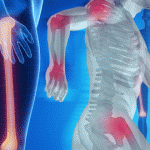NEW YORK (Reuters Health)—Patients with polymyalgia rheumatica (PMR) and giant-cell arteritis (GCA) have similarly increased risks of fracture, compared with the general population, researchers have found. “It is of surprise that patients with GCA have a similar fracture risk to those with PMR,” Dr. Zoe Paskins from Keele University, in Staffordshire, told Reuters Health by…
Search results for: vertebral fracture
Use Epidural Steroid Injections Cautiously in Patients with Fracture Risk
NEW YORK (Reuters Health)—Use of epidural steroid injections (ESIs) “should be approached with prudence,” particularly in patients who are at risk for osteoporotic fractures, such as women of postmenopausal age, according to authors of a systematic review. Although the literature presents a mixed picture, ESIs in doses as low as 80 mg methylprednisolone equivalents seem…
Changes in Bone Markers Predict Fracture Reduction with Anti-Resorptive Drug
NEW YORK (Reuters Health)—Treatment-related changes in bone formation markers predict vertebral-fracture reduction with anti-resorptive drug therapy, according to a meta-regression analysis of 14 clinical trials. “These results may be useful for the development of new osteoporosis treatments or when considering new populations or dosing regimens with existing treatments,” Dr. Douglas C. Bauer from the University…
Bisphosphonates May Limit Fracture Risk in Users of Oral Glucocorticoids
NEW YORK (Reuters Health)—Early oral bisphosphonate use is associated with a lower risk of fractures among oral-glucocorticoid users, researchers from Canada report. Bisphosphonates are commonly used for glucocorticoid-induced osteoporosis, but their efficacy has been established only in primary osteoporosis, where the mechanism of action of bone loss differs from that seen with glucocorticoid use. Dr….

Sequential Therapy May Reduce Hip Fracture Risk; Plus New Biosimilar Available in Canada
Patients who receive abaloparatide and switch to alendronate have a statistically significant reduction in fracture risk through 3.5 years, according to a new study…
Undetected Fractures Linked to Back Pain in Older Men
(Reuters Health)—About three in five older men with tiny spinal fractures related to osteoporosis reported new or worsening back pain in a new study. Only about one-quarter of new vertebral fractures are diagnosed by a doctor, the study team writes in their September 7 online report in Journal of Bone and Mineral Research, though the…

A New Approach to Fracture Prevention
Glucocorticoids are widely prescribed by rheumatologists, and the effects of daily and cumulative doses of these drugs on bone mineral density (BMD) are important elements of a draft clinical guideline document presented on Nov. 13 at the 2016 ACR/ARHP Annual Meeting in Washington, D.C. Leaders of the ACR guideline project discussed their recommendations at the…
Denosumab Linked to Rebound-Associated Fractures in Nine Patients
NEW YORK (Reuters Health)—Patients can develop rebound-associated vertebral fractures after stopping denosumab, a new report of nine cases shows. All of the patients were considered to be at low risk of fracture, and the fractures occurred within nine to 16 months of their last injection, Dr. Olivier Lamy and colleagues from Lausanne University Hospital in Switzerland…

The ACR Addresses the FDA about the Safe Adoption of Biosimilars in the U.S.; Plus Tofacitinib Approved for RA & Romosozumab May Reduce Fracture Risk
The ACR has continued its advocacy to ensure the safe adoption of biosimilars in the U.S., most recently addressing an FDA public hearing. Also, the FDA has approved tofacitinib for RA, and a clinical trial of romosozumab for patients with osteoporosis met its primary endpoint…

Abaloparatide-SC May Reduce Fractures for Osteoporosis & New FDA Safety Website
In a 25 month Phase 3 trial, abaloparatide-SC reduced the risk of new fractures in patients suffering from postmenopausal osteoporosis. Plus, the FDA launches a new drug safety website.
- « Previous Page
- 1
- 2
- 3
- 4
- …
- 12
- Next Page »